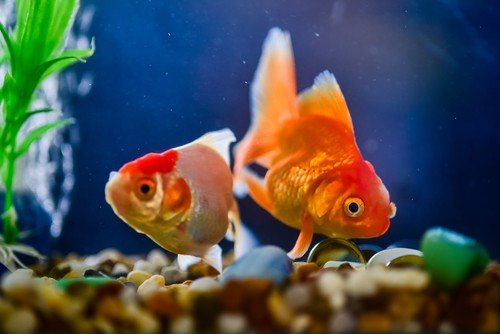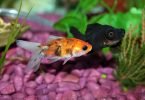Most of the aquarium holders face the problem of fish diseases at some stage. And, for many of the aquarium owners, velvet in fish is a quite common term. Even with this elegant name, there is no scope for you to be careless about this problem. However, it is a parasitic disease in both tropical and saltwater fishes.
Oodinium, a small parasite is responsible for velvet disease in fish. Generally, this parasite sticks to the fish skin, especially to the gills. Also, their fins can be affected. Moreover, this disease has several other names, such as – Rust, Gold Dust. In this article, we will focus on the probable causes, symptoms, and treatments of velvet disease in aquarium fish.
To know more about different Saltwater and Freshwater Aquarium Fish Diseases, click this article “Aquarium Fish Diseases: Causes, Symptoms, and Treatments“.
Causes of velvet in fish
This particular skin disease can be deadly for freshwater and saltwater fishes. However, two different types of Oodinium cause velvet disease in them. Here is the list.
Type | Parasite Name |
Saltwater fish velvet disease | Oodinium pillularis |
Tropical fish velvet disease | Amyloodinium ocellatum |
Source – https://en.wikipedia.org/wiki/Oodinium
Among tropical fishes, goldfish is one of the most vulnerable breeds of this disease. Also, betta and zebra danios may often fall victim to velvet disease.
However, the common causes of velvet in fish are given below.
- Skipping the step of quarantining your fish before the final water contact can cost you a lot. In that way, the fish skin may become a habitat for the velvet parasite.
- Oodinium can come from the aquarium plants. Therefore, you have to keep them germ-free.
- Lack of water filtration may initialize the risk of velvet disease in your aquarium. Also, dirty and damp conditions of water help to increase the constancy of parasites.
- Radical temperamental transformation may put your fishes in a state of distress. Moreover, this condition may lead to further growth of parasites like Oodinium.
- Weak immunity and physical inflexibility in your pets make them susceptible to parasites and bacteria. As a result, velvet in fish can be a widespread occurrence.
The life cycle of Oodinium (The velvet disease parasite)
Oodinium follows these sequences to complete their life cycle.
- Firstly, Oodinium attacks the host in the form of a dinospore. Dinospore can swim and float over the water surface while searching for a perfect host.
- Secondly, when the dinospore finds a host to connect itself, a solid covering is created over the spore’s body. Consequently, the outer shell protects it from harmful environmental obstacles.
- However, the shell formation stage is the cyst stage. Also, the cyst starts to take over the fish’s skin gradually. Moreover, a dust-like coating is seen outside the skin layer of the host.
- Next, the cyst falls off and releases another group of dinospores.
- Lastly, the cycle again starts from the dinospore. However, the first two days after release is critical. This is because; the spores die if they do not find a body to attach within this time.
Symptoms of velvet in fish
We can divide the symptoms of this disease into two phases because the primary symptoms may be different from the critical stage signs. However, if you notice any of the following signs in your fish, possibly your fish is suffering from the velvet disease.
Primary Stage symptoms

Critical Stage symptoms

Sometimes, in the most critical conditions, the usual pattern of breathing may change. Moreover, in the worst case, the fish skin coating may pull off gradually.
How to cure velvet in fish
Treatment of velvet in fish
Like some other skin diseases, velvet in fish is extremely transmittable. However, early diagnosis and proper treatment can reduce the risk of this disease. Also, precautionary measures decrease the chance of further spreading.
Adjust the current water condition
Before you start any treatment, it is necessary to check the water temperature and freshness. Moreover, you should supervise the water pH level and chemical presence (ammonia, nitrite, nitrate, etc..).
For that purpose, we recommend API Test Kits, for Variety of Water Parameters. It is a multi-purpose water kit to keep track of the water condition of your aquarium.
Pros
- Trouble-free use
- Instant result
- Gives accurate outcome of chemical levels
Cons
- Given color chart may vary sometimes.
Increase the water temperature
In the case of a tropical fish tank, this method especially works well. However, to interrupt the life cycle of Oodinium, try to set the temperature up to 82° Fahrenheit. Therefore, you will be able to accelerate their life cycle stages. Thus, you can rapidly move on to the treatment procedure for velvet in fishes.
Create a dim atmosphere
Oodinium parasites prefer low light conditions to complete their journey. So, try to cover the fish tank with a dark-colored plastic sheet or simply switch off the tank light.
Initiate the copper sulfate treatment
Copper sulfate treatment for the eradication of Oodinium is mostly effective. However, it should be used in an accurate amount. Otherwise, the toxic level can kill the invertebrates’ inside the tank. Also, it can be harmful to the fishes.
To generate this method, we suggest Seachem Cupramine Copper. This product is suitable for both saltwater and freshwater velvet parasite removal.
Pros
- Eliminates Oodinium efficiently
- Less harmful toxin level for fishes
- Does not affect the filter bed
Cons
- Overdose may become dangerous.
You should abide by the instructions carefully while using the product. Moreover, regular water condition check-up is also vital. In addition, you should not use copper on the fish tank directly where there are other fishes. Therefore, it is best to use an alternative tank to carry on the treatment of the affected fish.
To get an accurate water concentration level, it may take several weeks to one month. After that, filter the water to get rid of the further copper level.
Use alternative of copper
Some breeds of aquarium fishes may not endure the copper salt dosage. Ask your pet doctor for suggestions. However, methylene blue or Quinine Sulphate can be used under proper guidance.
Get rid of activated carbon
If you conduct any treatment session in your fish tank, it is essential to eliminate the activated carbon layer from the filter. Otherwise, its presence may reduce the efficiency of other chemical medications.
To know more about the treatments of velvet disease in fish, follow the video links.
Prevention from velvet in fish
- An aquarium should not contain dirty water. So, try to change the water with an interval of two or three days. This procedure depends on the fish tank capacity.
- Regular water filtration maintains the healthy hygiene and nourishment of the water. Maintain a routine to monitor the filter condition of your tank.
- Aquarium salt can be a great product to grow the normal mucus on your fish’s skin. Moreover, this step keeps away the parasitic attack from your fish. Additionally, water osmotic pressure can be leveled through this process.
- Keep your fishes stress free. Any stressful situation can lead to various sicknesses. On top, it can affect the skin condition.
- While adding fish to your tank, be careful about the tank capacity because a jam-packed area with fishes will enhance the possibility of skin infections.
- You should follow some techniques while feeding the fishes. Make sure you are arranging for properly nutritious and clean food habits. Moreover, add the foods in small portions. That will formulate hygienic and fresh environment inside the tank.
- Velvet in fish comes typically with a new member of your aquarium. So, whenever you buy a new one, make sure to quarantine it. As a result, during your observation period, you will get ideas about the behavior patterns of the new fish. In addition, signs of potential physical illnesses will also catch your attention at this time.
It is not so difficult to get rid of velvet on fish. Moreover, your concerned steps can lessen the chance of a potential parasite attack. As always, preventive movements are far better than treatments in this case. Here are some tips for your help.
Conclusion
Any skin disease can be an alarming situation for the fishes inside a tank. On top of that, a contagious infection like velvet in fish can threaten the other aquarium residents. Therefore, unexpected behavioral changes or physical discomfort of your pet fish should be taken seriously.
Starting and operating an aquarium somewhat needs an overall package of your time and effort. That is why; you never want to ruin it. Hence, it is important to prevent the event of an infectious disease like velvet. Otherwise, the treatment can sometimes make you start over a lot of things in your aquarium. To sum up, your prior actions can make a lot of difference.
To know more about different Saltwater and Freshwater Aquarium Fish Diseases, click this article “Aquarium Fish Diseases: Causes, Symptoms, and Treatments“.






